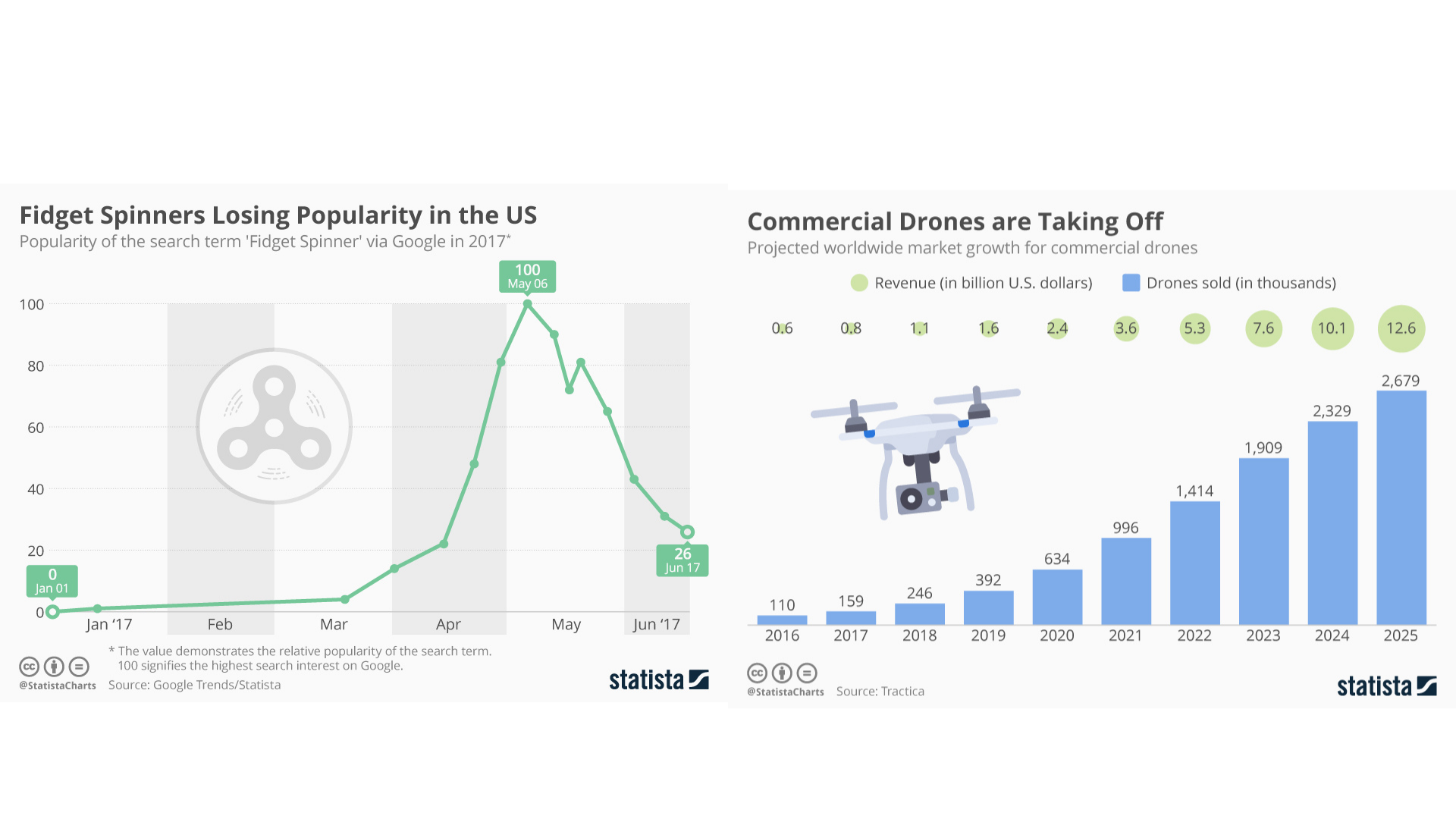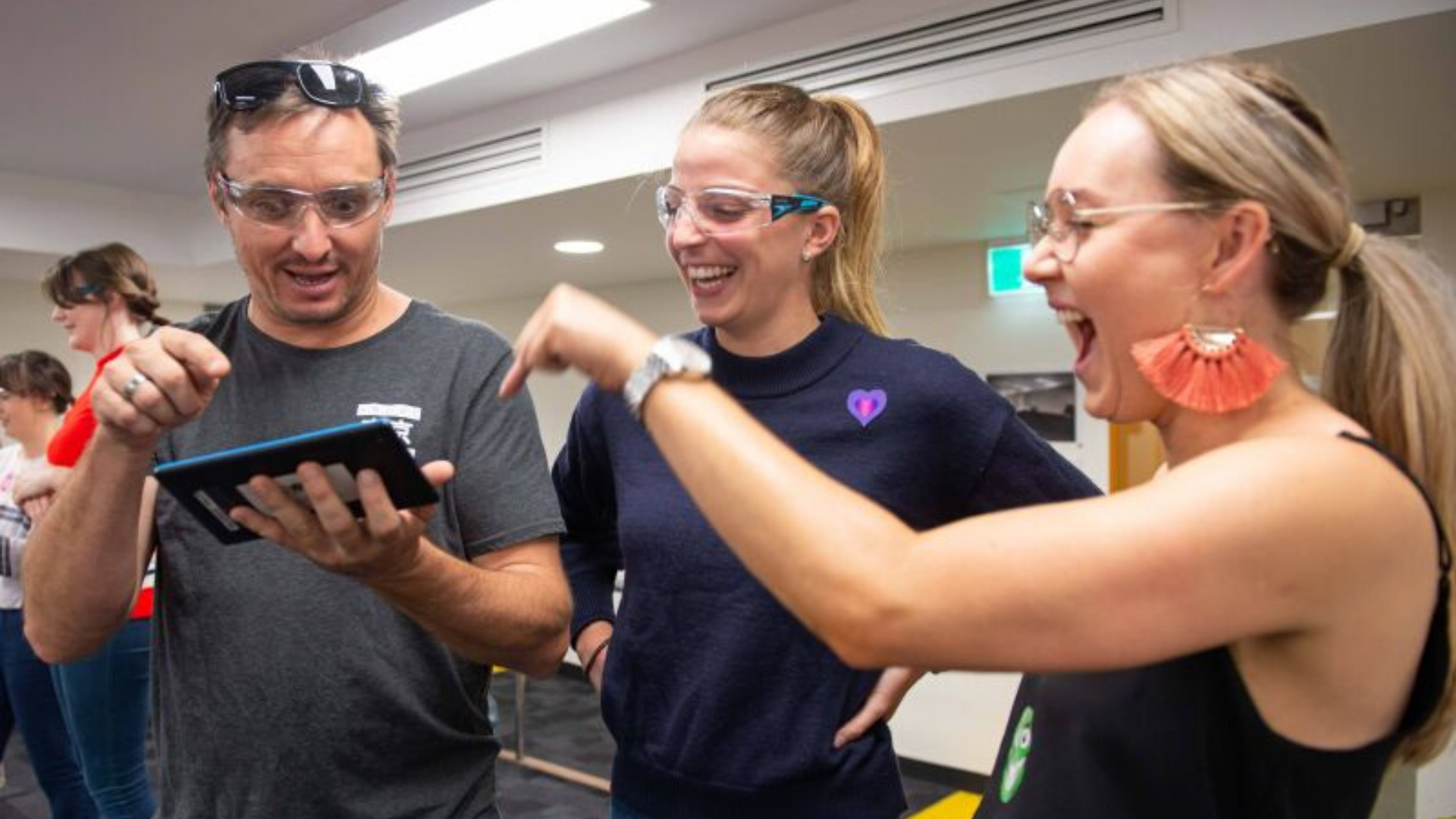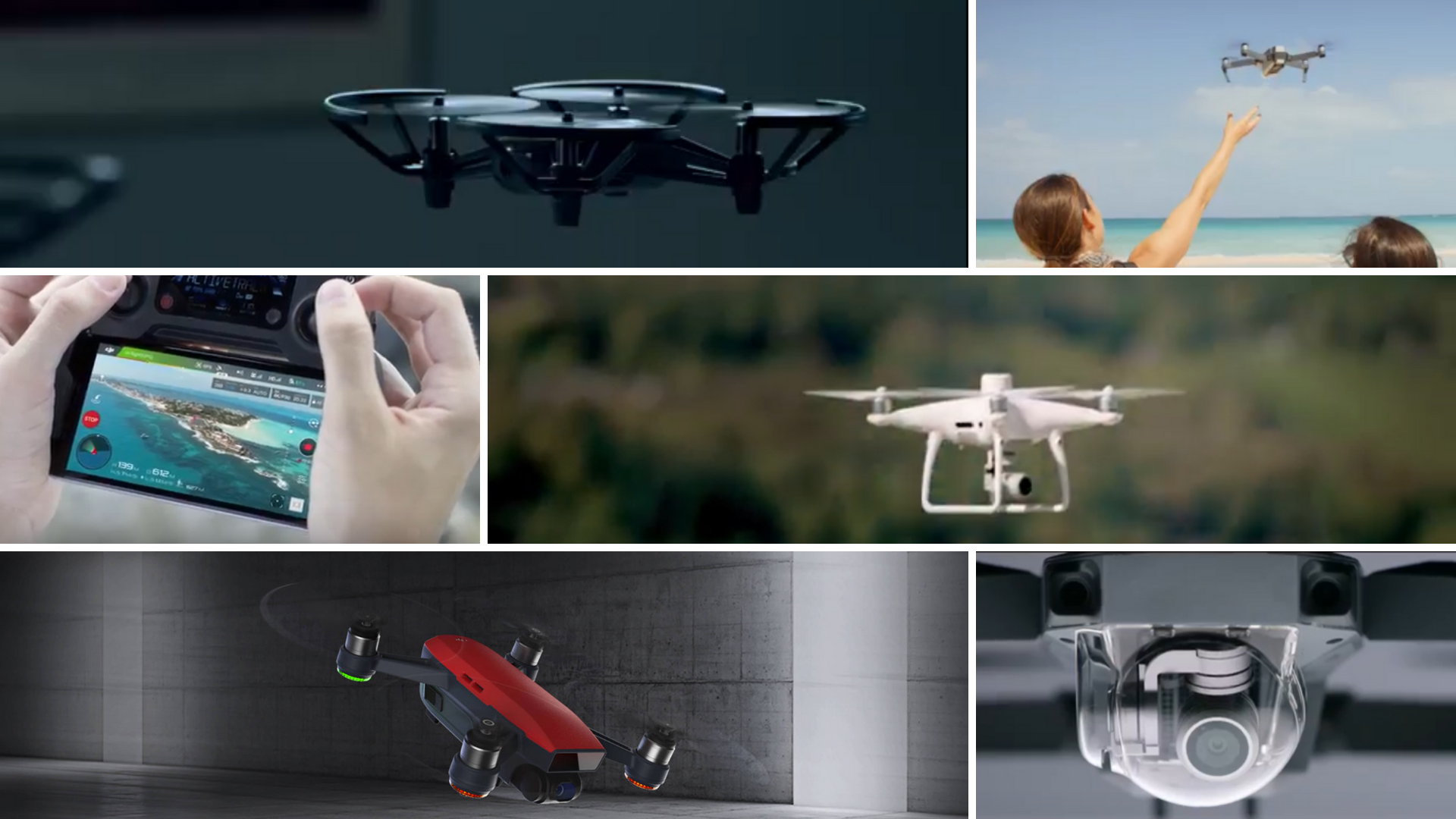A lot of technology ends up as a short-lived craze. Tamagotchis, anyone?
And it’s not just at home where we get sucked in. Any teacher working in a STEM department knows what that storeroom looks like. The longer you’ve been teaching, the more tales you have to tell.
One of the reasons we teach drones in schools is because we firmly believe they’re not a fad. Take a look at our highly scientific comparison below.
On the left, we have the fidget spinner. On the right, projected drone sales from technology market intelligence firm,
Tractica.

In 2017, schools in America started
banning the fidget spinner, labelling it as a distraction.
The thing is, they didn’t need to bother. Sales of the fidget spinner peaked in May 2017, accounting for
17% of all toy sales. Interestingly, a third of these were mothers who clearly saw the distracting features as a benefit! After 2017? The graph of internet searches below gives you some indication.
I think we can all agree that fidget spinners and drones are not a great comparison. We just wanted to give fidget spinners a final ‘spin’ in our articles before they fade into the tech abyss.
The point is that drones are here to stay and that’s a very compelling reason to have a drone curriculum in any STEM program and teach kids how to use them. But it’s not the only reason. What makes something stick around for educators has to go far beyond that.
These are the 19 reasons we think kids should learn to fly drones in the classroom.
1. The Adorable Look on Their Faces
Any parent or teacher can attest that this one gets them every time. As soon as that drone is up in the air, all eyes are transfixed on it. There’s a mix of excitement, confidence and wonder in the air. And that’s just the teachers ↓

2. Their Brains are Wired for Technology
Kids grow up with technology today in a way that we never did. Those formative neurological pathways give them a huge advantage when they take drone lessons and fly them for the first time. This is especially true for students who have spent any time playing with games consoles. The cognitive and motor skills are there, it’s often just the confidence that isn’t.
3. Drones Give Maths Teachers a Huge Reprieve
There is a theory out there that people find maths difficult because of how recently the language of mathematics was created.
I.e. the language we use to talk to each other has evolved, but it’s
been around for 30-100,000 years. Therefore, it feels easier or more intuitive. When the language of mathematics was discovered or invented is debated, but probably no more than 3,000 years ago.
Regardless of how accurate the theory is, we all know that maths is not a lot of people’s favourite subject at school.
Drones give Maths teachers an opportunity to make the abstract real for their students. Students can calculate distances, read graphs and use data that they create themselves from simple flight paths.
4. Educational Drones Lend Themselves to Intrinsic Motivation
Using a tool in the classroom that students feel intrinsically motivated to use is a godsend for any teacher. For intrinsic motivation to be possible, people have to feel spontaneous curiosity or excitement to explore. Drones do this because…
5. Viewing the World From Up High is Exciting and Intuitive
Hot air balloon rides, scenic helicopter flights, getting to the top of a mountain – there’s plenty to love about a great view. People like an aerial perspective – a sense of space and discovery of what’s beyond their normal field of vision.
While gathering aerial data might seem like quite a new phenomenon, we’ve actually been doing it for centuries with the invention of hot air ballooning. One man was so taken with his hot air balloon trip in 1785 that he wanted to recreate the experience for people on the ground.
He created what are believed to be the first-ever “balloon maps” – an illustrated map where a person would roll up a piece of paper and look through it while slowly moving it over the drawing.
Plenty more entrepreneurs followed suit with variations of the same theme – we thoroughly recommend this
Atlas Obscura article for a more comprehensive history of the bizarre and charming techniques people used before aerial technology became accessible.
 A “Bird’s Eye View” map of New Hampshire’s White Mountains, centering the summit of Mount Washington. OSHER MAP LIBRARY AND SMITH CENTER FOR CARTOGRAPHIC EDUCATION, UNIVERSITY OF SOUTHERN MAINE
A “Bird’s Eye View” map of New Hampshire’s White Mountains, centering the summit of Mount Washington. OSHER MAP LIBRARY AND SMITH CENTER FOR CARTOGRAPHIC EDUCATION, UNIVERSITY OF SOUTHERN MAINE
6. Drones are Fun!
If the boom of the toy drone market is anything to go by, it’s pretty safe to say that kids find drones fun. It’s incredibly easy to gamify the collection of data or have students work on their coding skills by creating a choreographed dance.
7. Flying Drones Instills Confidence
We mentioned that often confidence is the missing piece of the drone flying puzzle. The great thing about using drones, particularly microdrones, is that they are very student-friendly. Very easy to use = quick confidence growth.
In our experience,
we see the biggest growth of confidence in girls, hence why we’re called She Maps. As girls start to enter their teen years, they often experience self-consciousness and self-doubt around using technology.
We use drones to help combat that. Our tip for teachers is to provide students with an informative start. Explain how drones work, give reassurance and a decent safety briefing.
Let them know that they will probably crash and that’s totally ok. We take a more in-depth look at how to introduce drones into the classroom in our brand new Orbit portal for teachers.
8. Drones are Simple for Teachers to Learn
The expectation of implementing drone STEM curriculum in classrooms often forgets teachers. Specifically, that teachers are not experts at the technology they have to implement. On top of everything else that goes into making a classroom tick, this can feel really overwhelming.
The great thing about drones, particularly if you invest in ones with educational apps attached to them, is that they’re easy to learn. With a small amount of training, most teachers can easily work the controls, understand how to code flight paths, and feel confident enough to use them in the classroom.
9. Drones Easily Create Student-Centric Classrooms
A student-centred learning environment encourages students to be more independent and autonomous. It shifts the focus from the teacher to the students. This style of learning is also
very formative in helping kids shape their decision-making and
cooperation skills as they decide what and how things will get done.
We talk about using real-world applications with drones a lot and this is a great example of how teachers can bring student-centred learning in.
Our She Maps programs have students working together to capture aerial footage of a natural disaster. We know teachers who take this and expand on it, creating natural disaster project teams delivering food and capturing essential information (to be analysed later, of course).
10. Drones are Practical
How many professional development days do you end up learning a whole lot of theory that you then have to go away and figure out how to action into a lesson plan? We hear this from teachers a lot. Sometimes PD can end up creating more work. We don’t believe it should be like that. STEM professional development should be supportive.
Drones lend themselves to practical, actionable lessons. What you learn yourself, you pass onto students. You learn to fly drones, you teach your students to fly drones. You learn to code flight paths, you teach your students to code flight paths. You see where we’re going with this.
11. Drones Fit into All Sorts of Subjects
We primarily focus on using drones in science, technology, engineering and mathematics subjects, as well as vocational subjects adjacent to these areas. One of the reasons for this is because of the need for a large and diverse STEM workforce in the future to solve a lot of the world’s current problems.
But
drones go far beyond STEM subjects. Photography is an obvious choice and the technology here is becoming better and more affordable every year. Take a look at our guide about
which drone to buy for your classroom.
Drones can also be used in humanities subjects. For instance, how drones can be used to collect and communicate information in the news. Conversations also need to be had about the ethics around drone usage. And we’ve heard of history classes matching historic aerial footage of an area with new drone footage.
12. Drones are Really Cost-Effective
If you’re doing project work such as field trips to gather data from large flight paths then a more expensive drone is probably right for your classroom needs. But the great thing about this kind of project work is that you only need 1-2 educational drones per class.
Most teachers in more generalised subject areas or lower year levels can easily get away with using microdrones. They’re actually what we recommend for most classrooms for safety and ease of use.
A DJI Tello starts at around $169 AUD and we recommend 1 drone for every 3 students. Throw in an extra battery pack and you have technology for your classroom that will last a few years (depending on how much you use it) before the flight time starts to decrease significantly.
Take a look at our
Ultimate Guide to Buying a Drone for Your School to figure out what your classroom needs and then find out
which drone will meet those needs best.
 The Ultimate Guide to Buying A Drone For Your School
The Ultimate Guide to Buying A Drone For Your School
13. Drones Develop Enterprise Skills
Enterprise skills, soft skills, 21st Century skills – whatever you like to call them, they are the most in-demand skills for our future workforce.
Because of the ability to create real-world situations with drones, students are able to work together as they would in a future job. This means they develop crucial skills, such as:
-
- Decision making
- Innovative and original thinking
- Problem-solving
- Prioritisation
- Strategic thinking
- Working independently
- Being able to communicate professionally
14. Drones can see the Complex Issue
It’s not just Maths teachers, all teachers need to be able to teach students abstract concepts and issues. Drones help to do this because they can see the issue at hand with their own eyes.
Using one of our
image mats, students can see the information that they need to gather. When it comes to analysing that information, it’s much easier for them to use memory recall to deeply understand what it means.
15. Drones Help Students Understand the Concept of Data
Data is already everywhere and businesses and governments are picking up pace in developing sophisticated algorithms to use it.
As adults, our school education placed data firmly in science and maths class, and taught it in a very traditional sense. We’ve had to learn what this new pervasive level of data is that exists in the modern world today. You could argue that if we’d understood it better, we wouldn’t have as many ethical issues on our hands.
By the time students today become the workforce of the 2030s, data will be in almost every organisation. Using tools like drones where they see, understand and process data is crucial for student learning.

16. Drones Encourage Reward-Based and Active Learning
Creating a positive loop for students is incredibly motivational and a real confidence boost (see reason 7). As soon as a student gets a drone in the air there’s a positive feel-good reward. Of course, there will be times when a student has a mishap but we’ve never met a student who couldn’t operate a drone.
17. All Students are Included
The STEM workforce needs diversity of thinking, which means diversity of people. Drones can be operated by people of all types of bodies. Drones don’t care about race or gender. There is absolutely no conclusive science suggesting that boys have biologically better spatial skills than girls.
For kids who struggle with attention span, drones are a great tool because they provide variety. You don’t just sit and code with a drone, you code so that you can take flight. Then once you’ve flown, you have data that you can use in different ways. There’s a constant incentive to keep learning.

18. STEM by Stealth
Also known as incidental learning but STEM by stealth is, well, cooler – and let’s be honest, the STEM profession could use a bit of that.
This is feedback that we constantly get from teachers who use our programs:
Kids had such a good time that they often didn’t realise they were learning STEM skills and taking on knowledge when they were operating drones.
The dream.
19. Drones are Exploding as an Industry
And lastly, back to our intro point, drones are exploding as an industry and that is a great thing for education. It means that you can feel confident that you’re putting technology into the hands of your students that will be really relevant when they enter the workforce.
It means that more and more resources will become available for drone education teachers to use. We know we’re one of the first to offer tailored resources to teachers on how to teach drones in the classroom, but we won’t be the last!
It means that industry will see the benefit of giving back to the educational sector. We’re already seeing this with our sponsors, like
The Surveyors’ Trust. They genuinely want to connect in with schools and ensure that their industry thrives with a diverse range of people in the years to come.
And connecting students to a world beyond high school can only lead to greater perspective and more opportunities for them. Find out what else students can learn from drones in this
article.
Interested in finding out more about how to have fun at home with drones, then read
this article by Evan Dunn

 In 2017, schools in America started banning the fidget spinner, labelling it as a distraction.
The thing is, they didn’t need to bother. Sales of the fidget spinner peaked in May 2017, accounting for 17% of all toy sales. Interestingly, a third of these were mothers who clearly saw the distracting features as a benefit! After 2017? The graph of internet searches below gives you some indication.
I think we can all agree that fidget spinners and drones are not a great comparison. We just wanted to give fidget spinners a final ‘spin’ in our articles before they fade into the tech abyss.
The point is that drones are here to stay and that’s a very compelling reason to have a drone curriculum in any STEM program and teach kids how to use them. But it’s not the only reason. What makes something stick around for educators has to go far beyond that.
These are the 19 reasons we think kids should learn to fly drones in the classroom.
In 2017, schools in America started banning the fidget spinner, labelling it as a distraction.
The thing is, they didn’t need to bother. Sales of the fidget spinner peaked in May 2017, accounting for 17% of all toy sales. Interestingly, a third of these were mothers who clearly saw the distracting features as a benefit! After 2017? The graph of internet searches below gives you some indication.
I think we can all agree that fidget spinners and drones are not a great comparison. We just wanted to give fidget spinners a final ‘spin’ in our articles before they fade into the tech abyss.
The point is that drones are here to stay and that’s a very compelling reason to have a drone curriculum in any STEM program and teach kids how to use them. But it’s not the only reason. What makes something stick around for educators has to go far beyond that.
These are the 19 reasons we think kids should learn to fly drones in the classroom.

 A “Bird’s Eye View” map of New Hampshire’s White Mountains, centering the summit of Mount Washington. OSHER MAP LIBRARY AND SMITH CENTER FOR CARTOGRAPHIC EDUCATION, UNIVERSITY OF SOUTHERN MAINE
A “Bird’s Eye View” map of New Hampshire’s White Mountains, centering the summit of Mount Washington. OSHER MAP LIBRARY AND SMITH CENTER FOR CARTOGRAPHIC EDUCATION, UNIVERSITY OF SOUTHERN MAINE
 The Ultimate Guide to Buying A Drone For Your School
The Ultimate Guide to Buying A Drone For Your School





